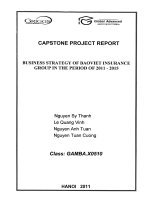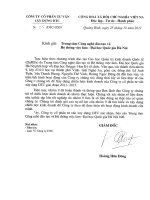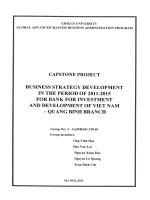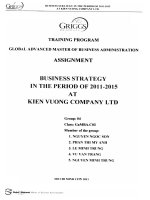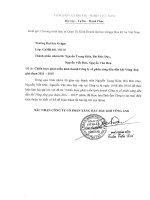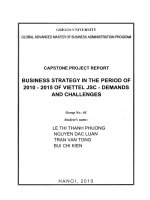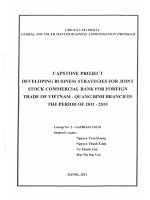Development strategy for petro capital and infrastructureinvestment joint stock company (petroland) in the period of 2011 - 2015
Bạn đang xem bản rút gọn của tài liệu. Xem và tải ngay bản đầy đủ của tài liệu tại đây (539.91 KB, 101 trang )
Capstone Project Report
~1~
GLOBAL ADVANCED MASTER OF BUSINESS
ADMINISTRATION
CAPSTONE PROJECT REPORT
DEVELOPMENT STRATEGY FOR PETRO
CAPITAL AND INFRASTRUCTURE
INVESTMENT JOINT STOCK COMPANY
(PETROLAND) IN THE PERIOD OF 2011 -
2015
Class : GaMBA01.C0609
Implemented by : Group No.6
Member : 1. Bui Minh Chinh
2. Nguyen Thien Loi
3. Nguyen Van Quan
4. Dang Thi Tam
5. Ho Thi Thanh Thao
6. Nguyen Duy Thinh
7. Nguyen Van Tuan
HCM CITY - 2011
Capstone Project Report
~2~
ACKNOWLEDGEMENT
After two years of learning and researching, with experience in working with many
lecturers, classmate, and with the objective of highest grasp of knowledge, our group
has gained various useful knowledge those we can used in our work
We would like to send our gratitude to all the lecturers those have devotedly given
us with useful knowledge, company’s management for their best condition provided to
us to complete our graduation assignment.
Best wishes are sent to Petroland.
Representative
Bui Minh Chinh
Capstone Project Report
~3~
Table of contents
Acknowledgement 2
Table of contents 3
List of tables 6
List of figures, graphs 6
Introduction 7
Chapter 1. Theoretical basis on business strategy and real estate business strategy
8
1.1. Definition, planning and implementation of strategy 8
1.1.1. Definition 8
1.1.2. Strategy planning and implementation 8
1.1.3. Some matrices commonly used in strategy planning 9
1.1.3.1. External factor evaluation Matrix - EFE 9
1.1.3.2. Internal factor evaluation Matrix - IFE 9
1.1.3.3. Competitive picture Matrix - CPM 9
1.1.3.4. SWOT Matrix 9
1.1.3.5. SPACE Matrix 10
1.1.3.6. QSPM Matrix 10
1.2. Model of five competitive forces of Michael Porter
10
1.3. Overview about real estate business in Vietnam 12
1.3.1. Office for lease market
12
1.3.2. Housing market
13
1.3.3. Trade center market
14
1.3.4. Tourism real estate market 14
1.3.5. Competition in real estate market 15
1.4. Necessity to make business strategy of Petroland 15
Capstone Project Report
~4~
Chapter 2. Introduction about Petroland and current state of its production and
business 16
2.1. Introduction about the Company 16
2.1.1. Establishment and development 16
2.1.2. Organizational structure 18
2.2. Overview about business activities of the Company 19
2.2.1. Business results of the Company 19
2.2.2. Situation of project implementation 21
2.3. Analysis of external environment 24
2.3.1. Macro environment 24
2.3.1.1. Economic environment 24
2.3.1.2. Political environment, policies and law 26
2.3.1.3. Socio-cultural environment 28
2.3.1.4. Technological environment 29
2.3.2. Micro economy 29
(1). Competitors 29
(2). Customers 31
(3). Supplier 33
(4). Alternative products 35
(5). Barrier from penetration into sector 36
2.3.3. Matrix of external factor evaluation – EFE 37
2.4. Analysis of internal environment 39
2.4.1. Financial capacity 39
2.4.2. Business capacity 39
2.4.3. Leading capacity 41
2.4.4. Human resources management 42
2.4.5. Marketing 43
Capstone Project Report
~5~
2.4.6. Matrix of internal factor evaluation – IFE 44
2.5. Analysis of matrices to strategically planning 46
2.5.1. Competitive Picture Matrix 46
2.5.2. SPACE Matrix 47
2.5.3. SWOT Matrix 48
2.5.4. QSPM Matrix 50
2.5.4.1. Market expansion strategy and business diversification strategy 50
2.5.4.2. Low expense strategy and product difference-making strategy 52
Chapter 3. Planning business strategy and solutions for Petroland 54
3.1. Planning Strategy 54
3.1.1. Forecasting the demand of Real Estate Market 54
3.1.2. Petroland’s mission and vision towards 2025 57
3.1.3. Overall and specific objectives of Petroland in the period of 2011-2015 57
3.1.3.1. The objectives of the projects 58
3.1.3.2. Targets for revenue and profit 73
3.1.4. Targeted market and customers 74
3.1.5. Selecting prior strategies 75
3.1.6. Competitive strategy 76
3.2. Strategy implementation solutions 78
3.2.1. Measures to implement strategy 78
3.2.2. Strategy organization, implementation and recommendations 89
3.2.2.1. Strategy organization, implementation of Petroland in 2011 – 2015 89
3.2.2.2. Recommendations to the State 90
Conclusion 93
Sources 94
Appendix 96
Capstone Project Report
~6~
List of tables
Table 2.1. Some basis financial data of Petroland 19
Table 2.2. Some financial ratios of Petroland 19
Table 3.1.The objective of revenue, profits and dividends in the period of 2011–2015
73
Table 3.2. Apartment area and number of bed rooms that customer need 81
Financial statements of Petroland in 2008, 2009, and 2010 96
List of figures, graphs
Figure 1.1. Model of five competitive forces of Michael Porter 11
Figure 2.1. Organization Chart of Petroland 18
Figure 2.2. GDP Per Capita in VietNam in the period of 2000-2010 25
Figure 2.3. Image of strategy (SPACE matrix) 48
Capstone Project Report
~7~
INTRODUCTION
“If we understand our situation and the competitors, we can always win victory;
otherwise, defeat is a certain result” Sun Tzu.
A company, an organization, an individual, a family that desires to gain success in
a final objective is required to identify a road. Market is like a battlefield, especially
for every company with responsibility to shareholders and employees. Therefore, all
companies should develop a proper business strategy as the basis for their business
operation in current time and future.
Business is like fighting "Sometimes it is as rapid as wind; sometimes as slow as
forest; sometimes aggressive as fire but sometimes as defensive as mountain”
Therefore, we must know how to orient, grasp the change, predict possible variations
and changes in the market; how to satisfy customers, keep loyal customers. All such
issues are contained in the business strategy of the company.
With the hope that our assignment can be applied in practice, we would like to
develop the assignment “Development strategy for Petroland in period of 2011-2015”
This is the first research conducted by us; therefore, there maybe some
shortcomings. So we hope that the university and Company’s management board will
give us constructive ideas for our improvement.
Representative
Bui Minh Chinh
Capstone Project Report
~8~
Chapter 1. Theoretical basis on business strategy and real estate business strategy
1.1. Definition, planning and implementation of strategy
1.1.1. Definition
According to Fred R. David, “Strategy is a series of the complicated action plans to
mobilize the resource of an organization to achieve a specific objective. Business
strategy may consist of development in geography, activity diversification,
capitalization, product development, market penetration, spending cut-down,
liquidation, and joint venture”.
(1)
1.1.2. Strategy planning and implementation
(1)
The strategy management is comprised of 03 stages:
+ Strategy establishment is a process of establishing the business tasks;
carrying out the research to determine the internal and external limitations; setting
long-term objectives; and selecting alternative strategies and typical strategies for
pursuit.
+ Strategy implementation requires company to establish the annual objectives,
proposal of policies, encouragement of personnel and distribution of resources to
implement the established strategy. Implementation of strategy is comprised to
development of a culture to support strategy in the establishment of effective structure,
orientation of activities, preparation of funds, development and use of information
system, encouragement of personnel’s operation.
+ Strategy evaluation will monitor the comment on results of established
activities and strategy implementation including the measurement of personal and
organizational achievements, and the actions to be adjusted.
(1) Fred R. David, translators: Truong Cong Minh, Tran Tuan Thac, Tran Thi Tuong Nhu (2006),
Concepts of Strategic Management, Statistics Publisher, Ha Noi city, VietNam.
Capstone Project Report
~9~
1.1.3. Some matrices commonly used in strategy planning
(1)
1.1.3.1. External factor evaluation Matrix - EFE
EFE matrix is often used for assessment of external factors to enable strategists to
summarize and evaluate economic, social, cultural, demographical, geographical,
political, governmental, legal, technological and competitive information. Therefore,
strategists can summarize the main opportunities and risks of external environment
affecting the operation of the enterprises in order to evaluate the response with such
opportunities and risks by the enterprise and determine if external factors impose
positive or negative impacts on the company.
1.1.3.2. Internal factor evaluation Matrix - IFE
Internal factor evaluation (IFE) matrix is a strategic management tool for auditing
or evaluating major strengths and weaknesses in functional areas of a business. IFE
matrix also provides a basis for identifying and evaluating relationships among those
areas. The IFE matrix is used in to use and promote strengths and find the solution to
mitigate the weakness.
1.1.3.3. Competitive picture Matrix - CPM
Competitive picture matrix is an essential strategic management tool to compare
the firm with the major competitors of the industry based on the factors affecting
competitiveness of the company in the industry. This help to provide the managers
with clear picture to the firm about their strong points and weak points relative to their
competitors; identify the competitive advantage of the company and the weakness to
be overcome.
1.1.3.4. SWOT Matrix
Strengths – Weaknesses – Opportunities – Threats matrix, SWOT provides a the
company to understand its weakness in business. Therefore, company can manage
(1) Fred R. David, translators: Truong Cong Minh, Tran Tuan Thac, Tran Thi Tuong Nhu (2006),
Concepts of Strategic Management, Statistics Publisher, Ha Noi city, VietNam.
Capstone Project Report
~10~
and eliminate risks those are not aware by the company. In addition, by using
comparison tool, and SWOT analysis between companies and competitors, company
can draft a strategy to distinguish company with the rivals, which facilitates company
to compete effectiveness in the market.
1.1.3.5. SPACE Matrix
SPACE matrix helps company to identify the what strategy is the most suitable
with the company among aggressive, conservative, defensive, competitive. The axis of
SPACE matrix represents two internal aspects of the organization (Financial strength
(FS) and competitive advantage (CA) and two external factors including
environmental stability and industry strength. These four factors are the most
important factors deciding the strategic position of the organization.
1.1.3.6. QSPM Matrix
The Quantitative Strategic Planning Matrix is a strategic tool which is used to
evaluate alternative set of strategies. QSPM identifies the attractiveness of various
strategies by making use of or improving key external and internal successful factors.
A QSPM matrix may consist of any quantity of strategies. However, only strategies in
a specific group must be evaluated together. For example, a group of strategies may
include backwards combination strategy, upwards combination strategy, and
associating combination strategy, while another group of strategies may include the
issue of share and sale of an unit of company to increase a necessary capital. These
two groups of strategies are completely different and QSPM only evaluates the
strategies in their group.
1.2. Model of five competitive forces of Michael Porter
(2)
According to Michael Porter, a leading strategy and competition planner,
competition intensity of the market of any production sector is under the impact of 5
forces as follows:
Capstone Project Report
~11~
Figure 1.1. Model of five competitive forces of Michael Porter
Source: />porter/
(1) Supplier power: supplier power is shown in following characteristics including
supplier concentration, importance of volume to supplier, differentiation of inputs,
impact of inputs on cost or differentiation, switching costs of firms in the industry,
presence of substitute inputs, threat of forward integration, cost relative to total
purchases in industry.
(2) Threat of substitute is shown in: switching costs, buyer inclination to substitute,
price performance trade-off of substitutes, relationship between price and quality of
substitutes.
(3) Potential competitors:
According to M-Porter, potential rivals are the firms those are not present in the
industry but may affect the sector in the future. The quantity of rivals, their pressure on
the industry will depend on following factors:
+ Attractiveness of the industry: this factor is expressed through indicators
including profit rate, quantity of customers, quantity of enterprise in the industry.
(2)
Threats from new entrant
Price pressure
Negotiating
power
of buyer
Of supplier
Threats
from
Alternative
products and
services
Supplier
Competitors in the
sector
Potential competitors
Alternative products
Buyer
Capstone Project Report
~12~
+ High entrance barrier is expressed in following factors including absolute cost
advantage, understanding in market fluctuation, approach to input factors, policy of
government, economic characteristic by scale, capital requirements, typical
characteristicsof commodity brand, switching cost of business industries, accessibility
to distribution channel, pay-back ability, exclusive products.
(4) Power of customer is shown in: bargaining leverage, buyer volume, buyer
information, brand identity, price sensitivity, threat of backward integration, product
differentiation, buyer concentration vs industry, substitutes available, buyer’s
incentives.
(5) Degree of rivalry: exit barrier, industry concentration, fixed costs/ value added,
industry growth, intermittent overcapacity, product differences, switching costs, brand
identity, diversity of rivals, corproate stakes.
1.3. Overview about real estate business in Vietnam
“Real estate business is the provision of investment capital to establish, buy,
receive transfer, lease, real estate lease and buy for sale, transfer, leasing, re-hiring to
gain profit.”
(3)
Since 1986, Real estate market has experienced three up and down periods including
1993-1999 (growth in 1993-1996, decrease in 1996-1999); 2000-2006 period (growth
in 2000-2003 and decree in 2004-2006), and since 2007 up to now (growth: 2007-
2008, decrease since early 2008).
(4)
1.3.1. Office for lease market
(5)
Office for lease segment is facing with price reduction for competition as the
supply source is increasing in the market.
(3) Tran Tien Khai (2011), Real Estate Principle, Society Labour Publisher, Ho Chi Minh city, Viet
Nam
(4) Many authors (2010), Viet Nam Real Estate Business, youth Publisher, Ho Chi Minh city, Viet
Nam.
(5) Reference from />
Capstone Project Report
~13~
At the end of 2010, this segment in Ho Chi Minh suffered from sharp reduction in
output and rental. This situation has not been improved in the early months of 2011.
Currently, many buildings are built and operated. In following period, offices for
lease will gain high increase in quantity; however, the actual leasing demand is
stopped at the moderate level compared with previous years
1.3.2. Housing market
(6)
High-class housing
Many high-class apartment projects will be finished in 2011 including Belleza
project, Duc Khai project in District 7, Tulip Van Phat Hung project, Riverside
Residence – Phu My Hưng and many other projects. Moreover, apartment investors try
to sell the apartments to return capital. This results in surplus in housing. It is predicted
that owners will reduce the price to avoid capital stagnation. Some projects will be
extended in progress pending more advantageous time.
House for medium-income people
Apartments for medium-income people is a segment of real demand since its price
is suitable with most of people. The statistics of Dat Lanh Real Estate Company shows
that the apartments are transacted at high rate in the market at the price of 500 million
to 5 billion VND, in which the apartments of less than 1 billion (about 15 million/m
2
)
represents about 80% of all transactions.
Today, high-class apartments are excessive; therefore, many enterprises including
domestic and foreign enterprises gradually shift to products for medium-income
people to increase the liquidity and rapid capital pay-back. According to real estate
experts, apartments of less than 1 billion VND (60m
2
to 100m
2
) in new urban areas
will be the segment of the most interest in the near future.
(6) Reference from />trung-binh-nhieu-tiem-nang/
Capstone Project Report
~14~
1.3.3. Trade center market
(7)
There will be additional supply of retail business sites to be launched in the market.
In the meanwhile, some previously-opened trade centers still face with difficulties in
lessees. This means the more and more violent competition in this sector. Moreover,
the policies to reduce inflation of the government impose negative impact on retail
market in current period. However, according to representatives of CB Richard Ellis
Vietnam Company (CBRE), trade center lease market in Vietnam is very potential,
since the shopping demand of domestic customers is potential. Vietnam is currently a
promising destination of many brands in the world.
1.3.4. Tourism real estate market
(8)
According to representative of CBRE, by quarter III/2010, the supply of the market
was about 11,000 villages and 10,000 resort apartments. The price of these villages
decrease from 1-1.5 million USD/villa to 200,000 – 800,000 USD/villa. About 85%
customers those buy tourism real estate products are Vietnamese; 10% overseas
Vietnamese, remaining percentage is foreigner. Among them, only 30% are the ones
with actual demand (apartment segment) at the average age of 38.
Vietnam is always an attractive site of tourism real estate investment thank to its
typical characteristics of Asia. Tourism and resort real estate market in Vietnam is
prospected to gain developing opportunities in the future, since it is a capital
maintenance channel of relatively high safety, especially in the period in which the
economy of Vietnam and the world is still impacted by global economic crisis and
increasing inflation.
(7) Reference from />mieng-banh-khong-de-xoi.htm; and />hang/10936751/87/
(8) Reference from
Capstone Project Report
~15~
1.3.5. Competition in real estate market
(9)
Real estate market in 2011 is evaluated to suffer from violent competition,
especially price competition. The investors with weak financial capacity will withdraw
from the market, and the market will not be attractive to non-professional new
entrants.
In the recent period, the investors normally implements project development before
adjustment made in acordance with the market. To ensure more effective project
investment in the future, the owner needs to carry out intensive market research prior
to the design of products suitable with the need of buyers and market. In addition, the
owners should implement good control of cost and propose proper sale and
competitive price strategies.
1.4. Necessity to make business strategy of Petroland
Globalization has created lots of opportunities for enterprises as well as fiercer and
fiercer competitiveness. In order to survive and develop, enterprises must be aware of
its position in the market, its destination and way to get there. That is reason why
enterprises need to make its strategies, and Petroland is not exception. Strategy
planning helps Petroland be aware of and take advantages of opportunities, minimize
negative impacts of adverse changes, and utilize its human resources most effectively.
Currently, real estate is making high profit, and has great growth potential.
Therefore, real estate enterprises have lots of opportunities to develop. However,
demand for capital of real estate is very great, thus it is much influenced by macro
economic factors. With great fluctuation of the economy, capital arrangement,
selection of market and products, activeness in adapting to changes in the market…are
critical to survival of real estate businesses. Thus, strategy planning is very significant
to Petroland.
(9) Reference from />newsview.aspx?cate=108&id=167
Capstone Project Report
~16~
Chapter 2. Introduction about Petroland and current state of its production and
business
2.1. Introduction about the Company
2.1.1. Establishment and development
Petroland has been established and come into official operation since 1
st
November
2007 in accordance with Business Registration Certificate issued on 29
th
October 2007
by Ho Chi Minh City’s Department of Planning and Investment, 4
th
registration for
changes on 7
th
August 2009 with charter capital of 1.000 billion dong which is
contributed from 6 shareholders, namely: PetroVietnam Construction Joint Stock
Corporation (PVC), PetroVietnam Finance Corporation (PVFC), PetroVietnam Oil
Corporation (PVOil), Ho Chi Minh City Infrastructure Investment Joint Stock
Company (CII), Bank for Investment and Development of Vietnam (BIDV) and
PetroVietnam Trade Union Finance Investment Corporation (PVFI). By 31
st
March
2010, shareholders of the Company have contributed enough registered charter capital.
In accordance with business license, the Company is permitted to operate in some
fields and provide different products and services. Main products and services are:
- Invest in construction and trading in new urban zones, residential zones, office for
lease; commercial centers, finance, hotels; urban technical infrastructure and
relevant services;
- Invest in construction, management the operation and trading and exploiting petrol
industrial zones; industrial zones using natural gas and other industrial zones;
- Invest in construction and trading seaport, river port; storage of petrol, gas, and
chemical;
- Consult in investment into construction, consult in project management;
management and exploitation of projects;
- Trade in real estate, materials and construction equipments;
- Carry out financial investment, sell and buy holdings, joint venture with domestic
Capstone Project Report
~17~
and foreign companies to implement investment projects;
- Perform in other business fields in accordance with legal legislation if Board of
Management see that it is beneficial for the Company;
Over the past time, the Company has been focusing on two main products and
services which are construction investment and providing consultant services in
construction. Since its establishment to the end of 2010, the Company has made lots of
achievements in business, it has been carrying out many big projects, products and
services of the Company are accepted by customers. Efforts and achievements in its
business have been recognized and commended by PCV, Petro Vietnam Group and
Ministry of Industry and Trade.
Capstone Project Report
~18~
2.1.2. Organizational structure
Figure 2.1. Organization Chart of Petroland
(Issued in attachment with the Decision no.846/QD-PETROLAND dated 29
th
March 2011 of
the Board of Directors of Petroland)
Board of shareholders
Board of Directors
Board of Management
Board of Control
Office
Personnel
Department
Finance
Department
Legal &
Communication
Department
Investment
Department
Planning
Department
Real Estate Trading
Center
Project Management
Board
Management Board of
New urban area Projects
Housing Exploitation
and Management
Enterprise
Petro Nha Trang
Investment Joint Stock
Company
Petro My Phu
Investment Joint Stock
Company
Petro Thang Long
Investment Joint Stock
Company
Petro Tay Ninh
Investment Joint Stock
Company
Capstone Project Report
~19~
2.2. Overview about business activities of the Company
2.2.1. Business results of the Company
Table 2.1. Some basis financial data of Petroland
Item Year 2008 Year 2009 Year 2010
Total net revenue 1,172,443,332 47,687,568,864 934,600,026,640
Compare with previous
year 3967.37% 1859.84%
Net Profit 29,032,948,052 24,087,406,704 173,042,714,518
Unappropriated profits 28,782,948,052 45,674,617,742 215,526,436,340
A. Working asset and
Short term investment 618,700,185,851 706,693,128,841 1,601,398,030,962
B. Long - term assets 370,422,735,490 384,922,687,321 741,837,055,555
Total asset 989,122,921,341 1,091,615,816,162 2,343,235,086,517
A. Payable Debts 22,719,973,289 105,442,903,614 1,123,553,997,003
I. Short term debts 22,719,973,289 105,093,903,614 790,633,031,520
II. Long term debts - 349,000,000 332,920,965,483
B. Capital Sources
of Shareholders 966,402,948,052 986,172,912,548 1,219,681,089,514
Paid – in capital 937,620,000,000 937,620,000,000 1,000,000,000,000
Total Capital 989,122,921,341 1,091,615,816,162 2,343,235,086,517
Source: Financial Statement of Petroland in 2008,2009 and 2010
Table 2.2. Some financial ratios of Petroland
No. Item Unit Year 2009 Year 2010
I Liquidity capability
1.1 Current Ratio times 6.72 2.03
1.2 Quick Ratio times 3.01 1.57
1.3 Interest cover ratio (EBIT/interest) times 31.07
II Financial leverage
2.1
Self-financing ratio
(Equity/Total capital) % 90.34% 52.05%
2.2 Debt ratio (Total debt/Total assets) % 9.66% 47.95%
Capstone Project Report
~20~
III Operational capability
3.1
Assets turnover
(Net revenue/ Average total assets) cycle 0.05 0.54
3.2 Net revenue / Average fixed assets cycle 0.28 3.10
3.3 Stock days days 1,974 192
3.4 Debtor's payment period days 559 189
3.5 Creditor's payment period days 580 126
IV Growth possibility
4.1 Rate of revenue growth % 3967.37% 1859.84%
4.2 Rate of profit growth % -17.03% 618.39%
V Profitability
5.1 Gross profit Margin % 25.19% 24.79%
5.2 Profit Margin % 50.51% 18.52%
5.3 Return on assets (ROA) % 2.32% 10.08%
5.4 Return on equity (ROE) % 2.47% 15.69%
5.5 Return on investment (ROI) % 2.57% 13.99%
5.6 EBIT/Net revenue % 56.13% 25.71%
5.7 Earning per share (EPS) VND 257 1,730
5.8 P/E 4.98
Source: Financial Statement of Petroland in 2008,2009 and 2010
Time to search, promote and invest in a real estate project is quite long (from 2 to 3
years). Therefore, during the first two years of operation, Petroland had almost no
revenue from selling real estate products. Majority of revenue in 2008 and 2009 was
from consultancy, project management and from financial activities (interest on
deposit in banks and investment trust). However, in 2010, with efforts of Board of
Leaders as well as staffs and officers of Petroland, together with retailing policies in
real estate trading floors, Petroland had gained revenue of 934.6 billion dong and after-
tax profit of 173 billion dong. This is an admiring achievement for a newly established
real estate company, especially in the context of freezing real estate market and
unstable economy.
The increase of revenue in 2010 had made profitable effect, thus ROE, ROA and
ROI strongly increased in comparison to previous years.
Capstone Project Report
~21~
The Company has used debt and advance deposit of customers to increase
efficiency of ownership utilization. Currently, debt ratio is 47.95%. This is quite safe
level and lower than companies operating in the same sectors (50%-70%)
(10)
. Interest
cover ratio is quite high, 31.07. This shows that Petroland has quite low financial risk.
Liquidity of the Company is also at safe level. In 2010, current ratio and quick ratio
is 2.03 and 1.57 respectively.
In general, financial situation of Petroland is quite good. Currently, financial
indicators of Petroland are at safe level. Although profitability of Petroland is lower
than average level of the sector (ROE of the sector is about 20%)
(11)
, with reasonable
investment and sales policies, together with available potentials, Petroland has great
potentials for development upcoming years.
2.2.2. Situation of project implementation
(12)
By the end of 2010, Petroland carried out many activities at the same time:
investment promotion, investment preparation, project investment, investment capital
contribution and providing consultant services – project management. The Company is
seeking for new projects and new investment opportunities. Below is situation of
promotion and implementation of projects.
Projects directly invested by Petroland:
- Phu My Hung Petrol Commercial and Financial Center (Petroland Tower) has 3
basements and 30 levels (1
st
to 3
rd
floor will be for commercial center, 4
th
to 24
th
floor will be for offices and 25
th
to 30
th
floor will be for hi-end apartments), total
floor space of over 57,000 square meter, total investment of 1,003.68 billion dong.
Body structure, completion, fire prevention system and M&E system of the project
have been finished. The tower is estimated to be inaugurated and taken into
(10) Synthesized from financial statements of some Real estate companies presented on
(11) Synthesized from />
(12) Internal Documents of Petroland (2010), Ho Chi Minh city, VietNam
Capstone Project Report
~22~
operation on 19
th
May 2011.
- Office Building 16 Truong Dinh. The Building has 1 basement and 10 levels with
total floor space of 2.800 m2, total investment capital of 42 billion dong. The project
has been completed and is being utilized.
- Apartment Building Petroland in District No 2. The Apartment Building has 2
blocks, 18 floors, total area of 54,000 m2 with 380 apartments of which area from 70
-130 m2/apartment, total investment of 700 billion dong. The project was
commenced on 21
st
March 2010. By 31
st
December 2010, execution of body
structure to 10
th
floor will be finished, 8 floors will be completed and M&E will
reach 70% of volume.
Projects in which Petroland contributes its capital:
- My Phu Apartment Building. This Apartment Building has 22 floors, was
commenced on 16
th
July 2010. In 2010, the execution of pile and foundation of the
basement was finished.
- Vung Tau new urban area. The Company has completed the planning and get
approval for the planning scale 1/500. The project is on the process of carrying out
procedures of compensation for resettlement. The project is on the stage of basic
design and establish investment project.
- In addition, the Company also invests into some work scheduled projects such as:
+ Commercial – Services Center, Offices and hi-end apartments in Street 30/4 Vung
Tau city.
+ Golf yard and Cam Ranh eco villas. The project has compensated and supported for
60/66 households and hand over site according to new boundary of the project.
+ Huynh Tan Phat Apartment Building: Cooperation contract has been signed between
Khang Thong Company, PIV Long Son, PVFC Land and Petroland. The project was
commenced on August 2010, execution of fence and test pile are completed.
+ Thang Long Apartment Building. The Company has signed contract with Vu Anh
Capstone Project Report
~23~
General Hospital Company Ltd and cooperate to establish a construction investment
and cooperation joint stock company with charter capital of 500 billion dong, in
which Petroland contributes 79.9%.
+ Tuong Binh Hiep Commercial Housing – Binh Duong. The Company has signed 3-
lateral cooperation contract with PetroVietnam Song Hong Investment and Trading
Corporation and PIV Long Son to invest in construction commercial housing with
total area of 30.6ha.
Projects on the stage of investment promotion:
- Xuan Thoi Son urban area project. Watching detailed plan 1/10.000, after being
approved, the Company will consider whether to invest or not.
- Ring road No 2 and land funds project. The Company is working with Department
of Natural Resources and Environment of HCMC, Land fund development center to
submit documents about land lots requested by Petroland.
- Hiep Phuoc Port project: In 2010, The Company continues to carry out its
investment promotion in the Hiep Phuoc Petroland Port project.
Consultancy – project management:
- Projects of which consultancy has been completed. Vung Tau Hotel project and Anh
Dao Kindergarten project.
- Projects on the process of consulting for project management and supervising: (1)
Dragon Tower Hi-end Office Building (investor is PVGas); (2) Complex of
Apartment and officer No 2 Nguyen Huu Canh – Vung Tau (investor is PVC MS);
(3) working place of Construction and Erection enterprise and Service Enterprise -
Vietsopetro (investor is Vietsopetro); (4) Investment in technical infrastructure for
residential areas for 2 and 3 areas Vi Thanh – Hau Giang (investor is PVC SG); (5)
Improve Guest House of Petro Vietnam (investor is Petrosetco); (6) Complex
Petrosetco Tower (investor is Petrosetco); (7) Commercial – Services Center, Offices
and hi-end apartments in Street 30/4 Vung Tau city (investor is PVC-IC); (8)
Capstone Project Report
~24~
Improve Holiday Mansion – Vung Tau (investor is Petrosetco); (9) My Phu
Apartment Building (investor is Petromyphu); (10) Site aggrading in Soai Rap –
Tien Giang petrol services industrial zone (investor is PVC); (1) Steel pipe of
straight welding factory – Tien Giang (investor is PV-PIPE); and (12) Other projects
have been promoted, introduced to investors.
2.3. Analysis of external environment
2.3.1. Macro environment
Impacts of macro economy on real estate enterprises in Vietnam is very great.
State’s policies such as tax, profit, foreign investment, population, economic activities
and people’s income have direct influences on supply and demand in real estate
market. Most of construction works of Petroland are located in Ho Chi Minh City, thus
indicators, policies and data relating to this area will be focused. Below are analysis of
influences of macro economy on business activities of Petroland.
2.3.1.1. Economic environment
Gross domestic income (GDP)
General Statistics Office has just announced official data about economic growth
of Vietnam’s economy in 2010. Accordingly, GDP by practical price reached 1.98
million billion dong, equivalent to 104.6 billion. In comparison in term of basis period
(1994), growth rate of GDP in Vietnam in 2010 reached 6.78% against 2009.
(13)
Regarding foreign direct investment, by 21
st
December 2010, there were 969
projects in Vietnam with total registered FDI of 17.23 billion USD.
(13)
In Ho Chi Minh City, average economic growth rate for 5 years (period 2005 –
20100 reached 11%. Economic scope of the city by 2010 were 1.7 times more than the
year 2005, GDP per capita in 2010 was estimated to be 2,800USD, 1.68 times more
than the year 2005.
(14)
GDP of the whole year 2010 reached 418,053 billion dong,
growth rate of 11.8%.
(15)
(13)
Capstone Project Report
~25~
Figure 2.2. GDP Per Capita in VietNam in the period of 2000-2010
Source: />viet-nam-nam-2010-va-trien-vong-nam-2011/
Chart and Figures about GDP growth in Vietnam in general and in HCMC in
particular show that people’s income have been more and more improved.
For the period 2011 – 2015, it is estimated that the world’s economy will be
recovered and Vietnam’s economy will reach growth rate of 6-7%/year
(16)
. Therefore,
real estate market will come back to its track.
Opportunity: People’s income have been more and more improved, economy will
be recovered and growth will be at high level period 2011 – 2015.
(14) />2800-usd-bang-168-lan-nam-2005.chn
(15)
(16) />doan-20112013.nd5-dt.143607.113121.html


